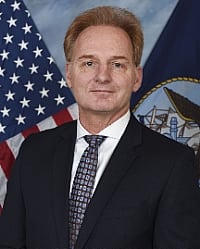The Acting Secretary of the Navy on Wednesday explained why the service is pushing plans to reach 355 ships within 10 years in the Force Structure Assessment (FSA) and said he would present the plans to the Secretary of Defense within days.
While speaking at a Center for Strategic and Budgetary Assessments event Wednesday, Thomas Modly noted the National Security Adviser is a proponent of the 355-ship fleet and President Trump mentioned it when he saw him during the Army-Navy football game in December.

Given this focus, Modly said the service needs to present a plan “and it needs to be not a 30-year plan, it needs to be something closer in, something within a decade. So what we’re trying to do is trying to align what we think the north stars are on this integrated force structure assessment, look at where we are today, and what can we do between now and 10 years from now to get as close to that structure as possible.”
Last week, Modly noted the Navy was looking at the FSA focusing on the next 10 years over a longer 30-year plan to reach 355 ships (Defense Daily, Jan. 24).
Earlier this month, Chief of Naval Operations Adm. Mike Gilday said the Navy needed more funding to reach 355 ships in a decade. “355 in 10? Sure, if we get the dough,” he said at the annual Surface Navy Association symposium (Defense Daily, Jan. 15).
On Wednesday Modly noted growing the fleet closer to 355 in a decade will require ship trade offs and not match the ideal force mix.
“We’re probably, based on the structure we have right now, we’ll be heavy on large surface combatants based on that mix. We’re going to be light on frigates because we’re not going to be able to bring that production capacity up to that level in terms of what we want by the end of the decade.”
Modly said under this plan the Navy is “going to be super late on unmanned stuff because we’re still in the research and development phase on that” and light on some other ship categories.
He also underscored there will be ranges of different categories in the final FSA “particularly the ones we don’t know that well. And the ones we don’t know that well the ranges are going to be big.” However, he expects the ranges to decrease as the Navy experiments, wargames and better understands how to use the new capabilities.
Despite these variables, Modly said he thinks it is his obligation to get the President and Secretary of Defense a plan for how to get to 355 ships at the lowest amount of cost in the near term.
After looking at how to get there, Modly said the department will look at the mix of ships “and say alright if we’re going to do this, are we building something that really makes sense for where we need to be 10 years from now. Or should we maybe change our trajectory, not get to 355 in 10, but move toward this new integrated force structure assessment at a different pace.”
Modly noted he will submit his recommendation the Secretary of defense in “a couple of days.”
He said the final FSA recommendation will probably be more than 355 traditional battle force ships in the mix plus a set of unmanned vessels. While he did not think counting unmanned vessels in the ship count changes much, Modly said Congress “has made it pretty clear that they don’t want us to count [unmanned] for now.”
Given how Congress has pared down the Navy’s near-term plans for unmanned vessels, Modly said he recognizes the Navy has not convinced Congress of where it wants to go with unmanned ships and has to do more to convince them. Meanwhile, the Navy will go as fast as it can given the funding Congress allocated.
“We’re trying to make the case for more of this. I think Congress, at least members on the SASC (Senate Armed Services Committee) particularly, have some reticence on us betting too much on this until it’s more of a proven technology.”
Modly said the Navy is now also looking into alternatives to purely unmanned vessels to assuage Congress and add flexibility. “Perhaps making it minimally manned or lightly manned initially and then if you move into a warfighting scenario, a high end fight you can put them out there unmanned so you put less people at risk.”
He noted, “frankly, we have to do a better job of selling to Congress on how this is going to fit into the mix.” This includes explaining how unmanned ships fit into plans, proving they have been wargammed through, and look through implications of integrating unmanned vessels into the fleet.
“So I get it. I understand why they’re hesitant to have us throw too much behind it. But I can tell you the Secretary of Defense is very, very interested in this and there are several members of Congress who are as well.”